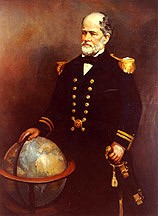Matthew Fontaine Maury (1806-1873)
Nicknamed "Pathfinder of the Seas," Matthew Fontaine Maury made important contributions to charting wind and ocean currents. His studies proved that by following the winds and currents ships could cross the ocean in fewer days than ever before.
In 1825 at age 19, Maury joined the United States Navy as a midshipman on board the frigate Brandywine. Almost immediately he began to study the seas and record methods of navigation. When a leg injury left him unfit for sea duty, Maury devoted his time to the study of navigation, meteorology, winds, and currents. His hard work on and love of plotting the oceans paid off when he became Superintendent of the Naval Observatory and head of the Depot of Charts and Instruments. Here Maury studied thousands of ships' logs and charts. He published the Wind and Current Chart of the North Atlantic, which showed sailors how to use the ocean's currents and winds to their advantage and drastically reduced the length of ocean voyages. Maury's uniform system of recording oceanographic data was adopted by navies and merchant marines around the world and was used to develop charts for all the major trade routes.
With the outbreak of the Civil War, Maury, a Virginian, resigned his commission as a U.S. Navy commander and joined the Confederacy. He spent the war in the South, as well as abroad in England, acquiring ships for the Confederacy. Following the war, Maury accepted a teaching position at the Virginia Military Institute in Lexington. He died at his home in Lexington in 1873 after completing an exhausting national lecture tour.
Something to Think About:
"Our planet is invested with two great oceans; one visible, the other invisible; one underfoot, the other overhead; one entirely envelopes it, the other covers about two thirds of its surface."
Matthew F. Maury
From The Physical Geography of the Seas and Its Meteorology, 1855
- Read the quote two or three times. What are the two great oceans Maury mentions?
- Why are both important to mariners?




